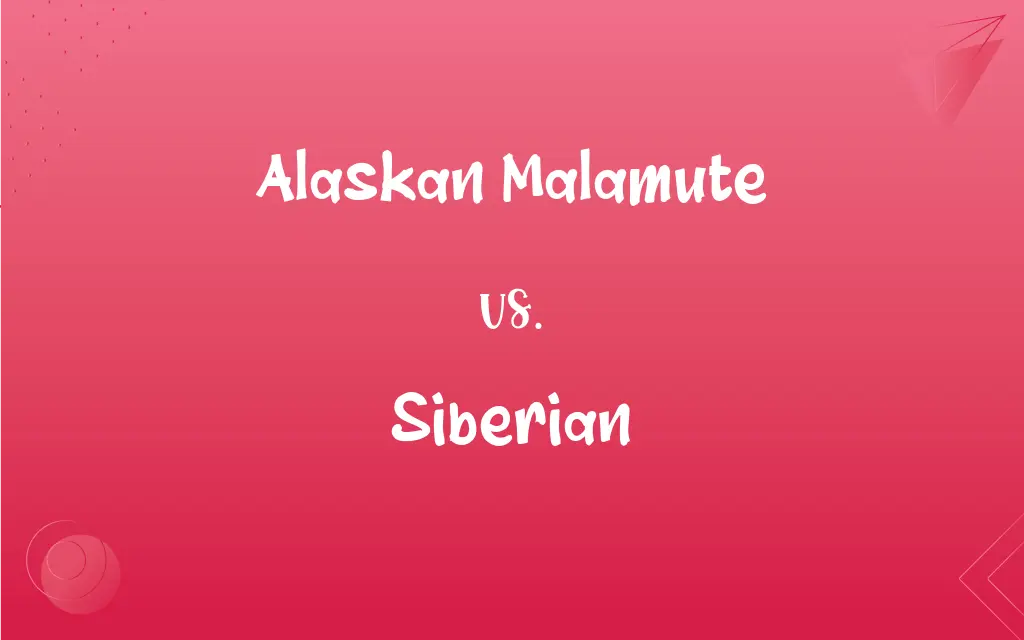Alaskan Malamute vs. Siberian: What's the Difference?
Edited by Aimie Carlson || By Harlon Moss || Updated on October 26, 2023
The Alaskan Malamute is a large sled dog breed originating from Alaska, while "Siberian" refers to anything related to Siberia, a vast region in Russia, including the Siberian Husky, another sled dog breed.

Key Differences
The Alaskan Malamute is a robust and sturdy breed of domesticated dog, known for its strength and endurance when it comes to hauling heavy freight. Originating from the cold, harsh environments of Alaska, these dogs were vital companions for the indigenous Mahlemut people. On the other hand, the term "Siberian" refers to the expansive and cold region in Russia. This region is known for its vast landscapes, unique climate, and diverse fauna.
In the context of dogs, when most people think of "Siberian", they often associate it with the Siberian Husky. Siberian Huskies are agile, quick, and have an innate ability to pull light loads over vast icy terrains. Alaskan Malamutes, in contrast, are built more for strength and can pull heavier loads, albeit at slower speeds.
Both the Alaskan Malamute and Siberian Huskies have thick, double coats to protect them from the biting cold. The Alaskan Malamute's coat is dense and woolly, designed for insulation. In the Siberian context, Siberian Huskies have a similar coat that allows them to thrive in the icy conditions of Siberia.
The Alaskan Malamute typically has a calmer demeanor and is known for its loyalty. They are often larger and more powerful in build compared to the Siberian Huskies. Siberians, particularly Siberian Huskies, are known for their playful nature, keen senses, and sometimes mischievous behavior. Both breeds, while distinct, represent a rich history and the incredible adaptation of animals to some of the planet's coldest regions.
Comparison Chart
Origin
Alaska
Siberia, Russia
ADVERTISEMENT
Typical Use
Hauling heavy freight
Pulling lighter loads quickly
Coat Texture
Dense and woolly
Thick with a similar double coat
General Demeanor
Calmer and loyal
Playful and sometimes mischievous
Size
Larger and more powerful
Medium-sized and agile
Alaskan Malamute and Siberian Definitions
Alaskan Malamute
A dog with a thick, double coat suitable for cold climates.
His Alaskan Malamute's dense fur keeps it warm during winter.
ADVERTISEMENT
Siberian
A descriptor for the Siberian Husky, a sled dog breed.
The Siberian's blue eyes captivated everyone at the dog park.
Alaskan Malamute
A breed closely associated with the Mahlemut tribe in Alaska.
The Alaskan Malamute's name is derived from the indigenous Mahlemut people.
Siberian
Pertaining to Siberia, a vast region in Russia.
The Siberian landscape is known for its icy terrains and cold climate.
Alaskan Malamute
A large dog breed known for its strength and endurance.
The Alaskan Malamute is adept at hauling heavy loads over long distances.
Siberian
Characterized by cold and harsh conditions, often in reference to weather.
The snowstorm brought Siberian temperatures to the region.
Alaskan Malamute
A loyal and sturdy companion animal.
The Alaskan Malamute is known for its unwavering loyalty to its owners.
Siberian
Related to the culture, climate, or inhabitants of Siberia.
She wore Siberian traditional attire for the cultural event.
Alaskan Malamute
A sled dog originating from the Alaskan region.
She wanted an Alaskan Malamute because of their history as sled dogs.
Siberian
An animal or plant originating from the Siberian region.
That Siberian tiger is one of the zoo's main attractions.
Siberian
Of or pertaining to Siberia, a region comprising all northern Asia and belonging to Russia; as, a Siberian winter.
Siberian
A native or inhabitant of Siberia
Siberian
Of or relating to or characteristic of Siberia or the Siberians;
Siberian natural resources
Siberian coal miners
The Siberian tundra
FAQs
How does the coat of an Alaskan Malamute differ from a Siberian Husky?
The Malamute's coat is dense and woolly, while the Siberian Husky has a similar but slightly less dense double coat.
What is an Alaskan Malamute?
It's a large sled dog breed known for its strength and endurance, originating from Alaska.
Where does the term "Siberian" come from?
It refers to anything related to Siberia, a vast region in Russia.
Is the Siberian Husky a type of Alaskan Malamute?
No, they are two distinct breeds, though both are sled dogs.
How big does an Alaskan Malamute get?
They can weigh between 75 to 85 pounds for females and 85 to 100 pounds for males.
Do Alaskan Malamutes shed a lot?
Yes, they have a thick double coat and go through significant shedding periods.
What's the primary use of Alaskan Malamutes?
They were primarily used for hauling heavy freight due to their strength.
Are Alaskan Malamutes good family dogs?
Yes, they are known for their loyalty and can be great with families when properly trained.
What do the terms "Alaskan" and "Siberian" signify?
"Alaskan" pertains to Alaska, while "Siberian" relates to Siberia in Russia.
What's the lifespan of a Siberian Husky?
Typically, they live 12 to 15 years with proper care.
What kind of exercise does an Alaskan Malamute need?
They require regular, vigorous exercise due to their high energy levels.
Are Siberian Huskies from Siberia?
Yes, Siberian Huskies originated from Siberia, Russia.
Are Siberian Huskies related to wolves?
All dogs share a common ancestry with wolves, but Siberian Huskies aren't directly descended from them.
Can Siberian Huskies be left off-leash?
It's not recommended as they have a high prey drive and can wander off.
What's the primary difference between an Alaskan Malamute and a Siberian Husky?
The Malamute is larger and built for strength, while the Siberian Husky is agile and built for speed.
Why is the Alaskan Malamute's tail often curved over its back?
It's a breed characteristic, serving to protect their face from snow when curled up.
What's the typical temperament of a Siberian Husky?
They are playful, agile, and sometimes can be mischievous.
How are Alaskan Malamutes with other animals?
They have a high prey drive, so careful introductions and training are essential.
Why are Siberian Huskies' eyes sometimes blue?
It's a genetic trait that many Siberian Huskies possess.
Can Alaskan Malamutes live in warm climates?
They can adapt, but they are best suited for colder climates due to their thick coat.
About Author
Written by
Harlon MossHarlon is a seasoned quality moderator and accomplished content writer for Difference Wiki. An alumnus of the prestigious University of California, he earned his degree in Computer Science. Leveraging his academic background, Harlon brings a meticulous and informed perspective to his work, ensuring content accuracy and excellence.
Edited by
Aimie CarlsonAimie Carlson, holding a master's degree in English literature, is a fervent English language enthusiast. She lends her writing talents to Difference Wiki, a prominent website that specializes in comparisons, offering readers insightful analyses that both captivate and inform.






































































